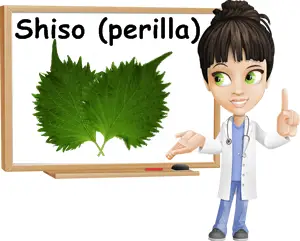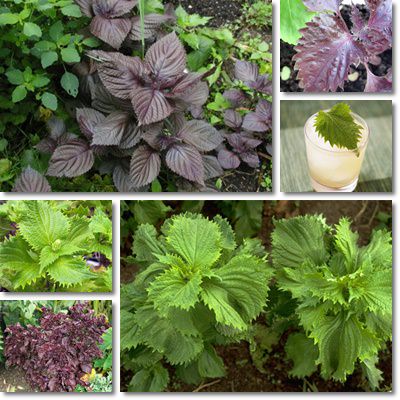The perilla or shiso plant (Perilla frutescens) is a potent herb and increasingly popular spice of the mint family. Shiso leaves, seeds and stems are widely used in traditional medicine practices to alleviate nausea and vomiting symptoms, treat abdominal cramps, food poisoning and infections and provide relief for cough and headaches.
In addition to its culinary use, the plant seeds and leaves are also the sources of two healthy oil varieties of growing popularity: perilla seed oil and perilla leaf oil.
Although herbal tea infusions are preferred for medicinal use, in recent years, shiso or perilla extracts have been made available in numerous Asian countries as part of natural allergy, cough or flu medicines.
The plant is also gaining quite a lot of popularity as a prominent culinary vegetable in Asian cuisine and is a preferred side dish. As a leafy green, it has made its way into traditional recipes such as pasta, ravioli, risotto and baked goods.

What does shiso (perilla) look like?
The green shiso plant is very similar in appearance to the stinging nettle, with beautiful bright green, serrated leaves, yet considerably rounder in shape. Another variety, the red shiso, has red-purple leaves and stems as a result of powerful anthocyanin pigments, compounds that occur naturally in the plant and boast potent antioxidant properties. Green varieties with purple elements are also commonly found.
Shiso is an important part of modern Japanese and Korean cuisines and although it is native to Japan, Korea, China and India, its naturalization in numerous temperate parts of the globe has lead to an uncontrollable spread. For this reason, shiso is considered to be a weed in certain countries in the US. The weed-variety can be easily distinguished from the edible shiso by its lack of fragrance.
What does shiso (perilla) taste like?
Shiso has a taste and texture similar to a lot like other leafy greens: light bitter flavors and tender leaves in young plants and a more pronounced bitter taste and tougher leaves in older plants. Shiso is a mint family plant which explains the twist in its flavor profile: faint, pleasant, minty-like aroma. But what would best describe the flavor profile of shiso is a basil-like taste with grassy, herbal, almost woody, licorice-like flavors from the volatile essential oils occurring naturally in the leaves.

What are the benefits of Shiso?
As far as its health benefits are concerned, the shiso plant boasts rather impressive antioxidant and antiviral properties. For instance, the red-purple pigment in red perilla leaves and stems is indicative of shisonin, a strong antioxidant anthocyanin and an aromatic compound with multiple beneficial health effects.
Aside from being an aromatic herb, shiso boasts a strong antioxidant activity, meaning it protects our cells from damage caused by reactive oxygen molecules called free radicals and thus helps, to a certain extent, reduce risks of certain chronic diseases as well as delay aging. As numerous experts suggest, diets rich in antioxidant foods such as shiso are the secret to longevity. Also, there is evidence that confirms there is a strong correlation between diet and lifespan and chronic disease prevention.
Shiso leaves have been found to have remarkable antibacterial and antiviral properties, which derive from the compounds that give the plant its natural flavor or spiciness.
In traditional Chinese medicine, shiso or perilla leaves infusions were used to treat persistent cough and stuffy nose symptoms.
Nowadays, shiso or perilla extracts, combined with other herbal extracts are widely present in pharmacies as approved natural medication for colds, flue and other respiratory tract infections.
Shiso tea or powder was believed to alleviate nausea and vomiting in pregnancy as well as relieve abdominal cramps as a result of indigestion or food poisoning.
However, pregnant women should consider talking with their doctor before consuming any herbal infusions because numerous herbs have the potential to cause uterine contractions which may lead to miscarriage or premature labor.
The shiso plant is highly appreciated in Asian cuisines for its spiciness and unique flavor as a result of powerful aromatic compounds such as rosmarinic acid. Studies suggest that consumption of foods rich in rosmarinic acid stops bacteria growth, hence the antiviral properties of shiso. Moreover rosmarinic acid in shiso boasts both anti-inflammatory and antibacterial properties and is thus efficient in treating food poisoning, common indigestion and offering relief for other mild digestive disorders.
Shiso (perilla) and allergies
Eating shiso (perilla) on a regular basis is said to reduce the severity of allergic reactions due to the ability of rosmarinic acid to inhibit the production of Interleukin-4 (IL-4). Interleukin-4-(IL-4) is a protein that causes specific immune cells to consider allergens, which are otherwise harmless agents, as pathogens and overreact. This excessive immune system response to otherwise innocuous compounds is the source of severe allergic reactions and asthma attacks in certain people.
However, despite study findings showing the anti-allergic properties of shiso, the plant in its natural form and in the amounts meant to be consumed (as food) does not constitute a definitive treatment for allergies or substitute vital medication. Other herbs rich in rosmarinic acid include thyme, basil, marjoram, lemon balm, peppermint and rosemary.
In addition to this, the shiso plant contains generous amounts of alpha-linolenic acid, a plant form of Omega-3 fatty acids, as well as linoleic acid (Omega-6) and oleic acid (Omega-9), all unsaturated fatty acids. As a result, not only does shiso plant consumption protect artery walls, preventing atherosclerosis and stroke, but also reduces inflammation.
Shiso/perilla oil
To maximize the benefits of the healthy unsaturated fatty acids in the plant, two oil varieties have been produced: shiso or perilla seed oil and leaf oil. The seed oil is especially rich in healthy unsaturated fatty acids.
In shiso or perilla seed oil, it’s the Omega-3 fatty acids that advance anti-inflammatory properties and associated benefits, whereas in shiso or perilla leaf oil it’s rosmarinic acid.
See benefits of perilla seed oil and benefits of perilla leaf oil. Last but not least, the leaves are a great source of calcium, potassium, iron, vitamins A, B2 and C which provide benefits for cardiovascular health, bones and eyes.
Shiso recipe ideas
In Asian cuisines, shiso (perilla) is as common as Brussels sprouts are in Western cuisine. In Korean, Japanese and Vietnamese cuisines, shiso sprouts are often used as a side dish to rice. Shiso leaves can be added to pasta, noodles or stews and even baked into pastry. Shiso seeds are consumed roasted and, unfortunately, salted. Alternatively, shiso seeds are grounded and used as powder spice or condiment to give flavor to stews. Perilla leaves can also be pickled, although they are highly appreciated in salads as well. Another very popular dish combines shiso leaves and sushi. Red shiso is much spicier than the green variety. Some say it has a powerful anise flavor. Green shiso is much more palatable, with a slight cinnamon flavor.
